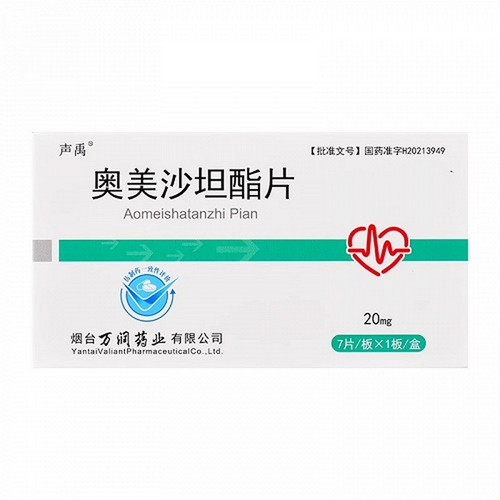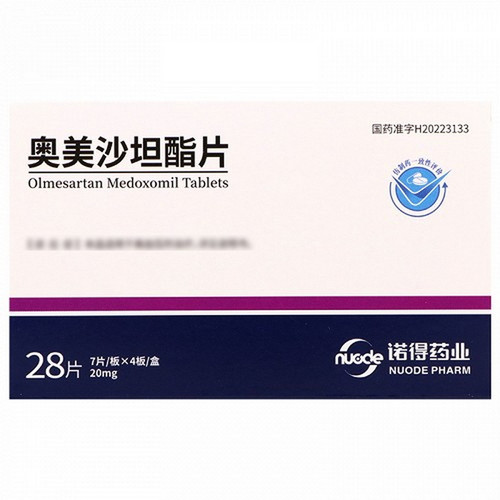Product Overview
[Drug Name]
Generic Name: Olmesartan Medoxomil Tablets
Trade Name: Xijia Olmesartan Medoxomil Tablets, 20mg x 7 tablets
[Main Ingredients]
The main ingredient of this product is Olmesartan Medoxomil.
[Properties]
This product is a white film-coated tablet that appears white after removal of the coating.
[Indications/Main Functions]
This product is indicated for the treatment of hypertension.
[Specifications]
20mg x 7 tablets
[Dosage and Administration]
The dosage should be individualized. In normovolemic patients, as monotherapy, the recommended starting dose is 20mg once daily. For patients who require further blood pressure lowering after two weeks of treatment, the dose can be increased to 40mg. Doses greater than 40mg have not demonstrated a greater antihypertensive effect. When the daily dose is the same, twice-daily dosing has not demonstrated superiority compared to once-daily dosing. This product can be taken with or without food. This product can be used in combination with other diuretics and other antihypertensive medications. No dose adjustment is required for elderly patients and patients with moderate to significant hepatic or renal impairment (creatinine clearance ≥ 40 min). Olmesartan medoxomil should be used under close medical supervision in patients with potential volume depletion (e.g., those receiving diuretics, especially those with renal impairment), and a lower starting dose may be considered.
Adverse Reactions
The safety of olmesartan medoxomil was evaluated in controlled clinical trials involving up to 3275 patients, of whom approximately 900 received treatment for at least 6 months and more than 525 received treatment for at least 1 year. Results showed that olmesartan medoxomil was well tolerated, with an adverse event rate similar to that in the placebo group. Adverse events were generally mild and transient, and were not related to dose, gender, age, or race. In placebo-controlled clinical trials, the only adverse event reported in patients receiving olmesartan medoxomil at a greater rate than in the placebo group was dizziness (3% vs. 1%). Adverse events with an incidence rate similar to that of the placebo group and greater than 1% include: back pain, bronchitis, increased creatine phosphokinase, diarrhea, headache, hematuria, hyperglycemia, hypertriglyceridemia, flu-like symptoms, pharyngitis, rhinitis and sinusitis. The incidence of cough was similar in patients in the placebo group (0.7%) and the Olmesartan medoxomil group (0.9%). Adverse events with an incidence rate similar to that of the placebo group, less than 1% and greater than 0.5% include: chest pain, fatigue, pain, peripheral edema, dizziness, abdominal pain, dyspepsia, gastroenteritis, nausea, tachycardia, hypercholesterolemia, hyperlipidemia, hyperuricemia, joint pain, arthritis, muscle pain, bone pain, rash and facial edema. It is not clear whether the above adverse events are related to the use of this product. Laboratory test results: In clinical controlled trials, changes in laboratory parameters with important clinical significance are rarely associated with Olmesartan medoxomil. Hemoglobin and hematocrit: Occasionally, hemoglobin and hematocrit Slight decreases occurred, with an average decrease of approximately 0.3 g/L and 0.3 volume percent, respectively. Liver function tests: Elevated liver enzymes and/or blood bilirubin were occasionally observed, but these levels returned to normal spontaneously. Past market experience suggests that there have been rare reports of rhabdomyolysis caused by angiotensin I receptor antagonists.
[Contraindications]
This product is contraindicated in patients with allergies to its ingredients.
[Drug Interactions]
Olmesartan is not metabolized by the hepatic cytochrome P450 system and has no effect on P450 enzymes. Therefore, drug interactions related to inhibition, induction, or metabolism of these enzymes are unlikely. Concomitant use of digoxin or warfarin in healthy subjects did not result in significant drug interactions. Concomitant use of the antacid A(OH)3/Mg(OH) 2. There is no significant change in the bioavailability of olmesartan.
Precautions
1. Renal Artery Stenosis: There have been reports that ACE inhibitors may increase serum creatinine or blood urea nitrogen (BUN) in patients with unilateral or bilateral renal artery stenosis. However, there is no experience with long-term use of this drug in such patients, but similar results may occur. 2. Renal Impairment: In patients whose renal function depends on the activity of the renin-angiotensin-aldosterone system (such as patients with severe congestive heart failure), the use of ACE inhibitors and ATT receptor antagonists may cause oliguria. and/or progressive azotemia, acute renal failure and/or death (rarely). Olmesartan therapy in such patients may also be expected to be associated with the following outcomes. 3 Fetal/neonatal morbidity and mortality In category D pregnancies (trimesters I and II), drugs that act directly on the renin-angiotensin system (RAS) have been associated with fetal and neonatal harm, including hypotension, neonatal craniosynostosis, anuria, reversible or irreversible renal failure and death. Oligohydramnios, preterm birth, intrauterine growth retardation and patent ductus arteriosus have also been reported, although It is not clear whether it is related to the medication. Once pregnancy is discovered, this product should be stopped as soon as possible. If medication is necessary, pregnant women should be informed of the potential harm of the drug to their fetus and serial ultrasound examinations should be performed to evaluate the situation in the amniotic membrane. Infants who have been exposed to angiotensin receptor antagonists in utero should be closely monitored for hypotension, oliguria and hyperkalemia, and appropriate treatment should be given when necessary. 4. Hypotension in patients with hypovolemia or hyponatremia Patients with hypovolemia or hyponatremia (such as those treated with high-dose diuretics) should be monitored closely for the first time. Symptomatic hypotension may occur after taking this drug, and treatment with this drug must be conducted under close medical supervision. If hypotension occurs, the patient should be placed in the supine position and, if necessary, receive an intravenous infusion of normal saline. Once blood pressure stabilizes, treatment with this drug can be continued.
Patients with Hepatic or Renal Insufficiency: No dose adjustment is required for patients with moderate to significant renal impairment (creatinine clearance <40 mcg/min) or moderate to significant hepatic impairment (see Special Populations under Pharmacokinetics).
Pediatric Use:
Safety and efficacy data for this drug in children have not been established.
Elderly Patients Dosage]
In clinical trials, no overall differences in efficacy or safety were observed between elderly and younger patients. No dose adjustment is required for elderly patients. However, the possibility of increased sensitivity in some older individuals cannot be ruled out.
[Overdose]
Data on human overdose are limited. The most likely manifestations of overdose are hypotension and tachycardia. Bradycardia may occur if the parasympathetic nervous system (vagus nerve) is stimulated. If symptomatic hypotension occurs, appropriate treatment and supportive care should be given. Can olmesartan be used? Elimination via hemodialysis is unknown.
[Pharmacology and Toxicology]
1. Pharmacological Action: Under the catalysis of angiotensin-converting enzyme (ACE, kinase I), angiotensin (Ang) is converted to angiotensin I (Ang). Angiotensin I is the primary pressor of the renin-angiotensin system. Its effects include vasoconstriction, promotion of aldosterone synthesis and release, cardiac stimulation, and increased sodium reabsorption by the kidneys. Olmesartan medoxomil is a prodrug that is absorbed and hydrolyzed into olmesartan via the gastrointestinal tract. Olmesartan is a selective angiotensin II receptor (A-AR). Olmesartan is an ACE inhibitor that blocks the renin-angiotensin system (RAS) by selectively blocking the binding of angiotensin to the vascular smooth muscle AT1 receptor, thereby blocking the vasoconstriction effect of angiotensin I. Therefore, its effect is independent of the AngI synthesis pathway. Olmesartan has an affinity for AT1 that is more than 12,500 times greater than its affinity for AT2. Blocking the renin-angiotensin system (RAS) with ACE inhibitors is a mechanism of action for many drugs used to treat hypertension, but ACE inhibitors also inhibit the degradation of bradykinin. Olmesartan medoxomil does not inhibit ACE, so it does not affect bradykinin. Whether this difference is clinically relevant is unclear. Blockade of angiotensin receptors inhibits the negative feedback regulation of renin secretion by angiotensin. However, the resulting increase in plasma renin activity and circulating angiotensin concentrations does not affect the antihypertensive effect of olmesartan. Toxicology Studies: In acute toxicity studies in mice and rats, no lethal results were observed at a single oral dose of up to 200 mg/g. The minimum lethal dose in dogs is greater than 1500 mg/kg. No carcinogenicity, teratogenicity, mutagenicity, reproductive toxicity, or genotoxicity was observed.






